The Legacy of Joseph Barnabas in Cyprus
Paul's mentor and missionary traveling companion
November 19th, 2011
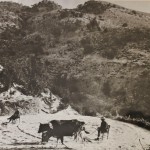 Hillside threshing area Today was a day for odds and ends. I had to fill out a lengthy report for the Fulbright folks. Good questions but time consuming to answer. My point is that I have no new discoveries about Barnabas to report–just yet. But I will say that I am getting some new information that is very important for my research. I just need to have the time to locate the sources and study them.
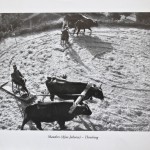 Note the way the driver just places a chair on top of the sledge So today’s blog is about threshing sledges. Periodically in the Bible, stories will mention threshing floors. At CAARI, tucked away in a corner, is an old threshing sledge. Although not truly ancient, it does reveal a lot about technology that has been around the Middle East for centuries. I decided to take some
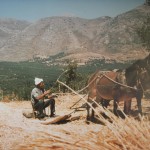 This photo is recent enough to be in color, but it is still an old picture pictures of it today and put them in this blog as a means of giving a mental picture that at least approximates some of what you read about in the Bible.
I also took photos of some old pictures from library books and two from photos hanging on the walls at CAARI. They are all of Cypriot threshing sledges, and reveal how farmers threshed their grain (separated the grain from the stalks).
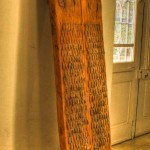 Threshing sledge at CAARI Notice in the photos of the sledge at CAARI the way in which the cutting stones are inserted into the wood of the sledge: narrower end pointed forward. You need to click on the
 Here is a closeup, showing the way the chipped stones are imbedded in the wood thumbnail size photos to get a larger picture in order to see the details. Once you see how the sledge works, some biblical stories will make more sense.
Pretty soon, I will present some of the juicy tidbits of information about the development of traditions about St Barnabas and the political and cultural causes for them. Reflecting as an outsider on the beliefs that developed on the island provides a good opportunity to be able to look objectively at data–because I am not personally involved in the belief system. As I do so, I am reminded of how difficult it is for me to look objectively at data regarding my own Christian traditions, especially when the data are collected by outsiders. It is a good lesson on the difficulties of being objective with one’s own belief systems.
Posted in Uncategorized | Comments Off on Threshing sledges
November 18th, 2011
 Bear chasing Christopher Robin 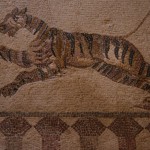 Tigger coming to rescue Christopher Robin  Grave complex for a rich family in Paphos. Christopher Robin does not want to go there.  Archway to the Mediterranean  Paphos promontory  Ancient theater at Paphos  Our next home, located on Coral Bay. We are rich, didn't you know? 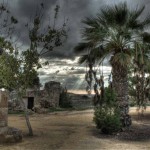 Entrance to the Paphos necropolis. People are just dying to get in here.
Posted in Uncategorized | Comments Off on Paphos Gallery
November 17th, 2011
We had a fun time seeing lots of cool sites in and around Paphos, on the west coast of Cyprus. We saw petrified snails in composite rock, ate their descendants, and observed a nice sunset over the Mediterranean.
The friendly restaurant owner asked Lynne if she ate snails. Earlier she said that she did not believe that she could ever eat snails. She did. I have photographic proof. “Not so bad,” she said, “as long as you don’t look at it before you pop it in your mouth.”
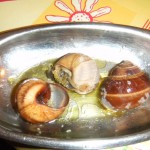 The challenge is set before Lynne. 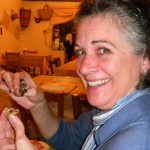 Lynne accepts the challenge 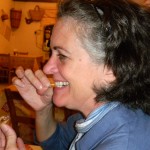 Incriminating evidence.  Ancient ancestors of part of our dinner, imbedded in rock. Interesting geology in Cyprus. 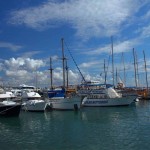 Paphos harbor. Photo taken from the table where we had lunch. No snails were eaten during this meal.
Posted in Uncategorized | Comments Off on Snails ancient and modern
November 13th, 2011
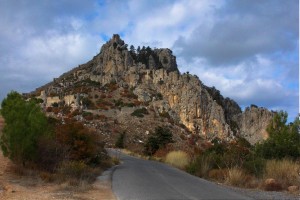 Hill of St. Hilarion's Castle with fall foliage. On Saturday, Lynne and I took the NEH representatives north into Turkish occupied Cyprus. We went first to St. Hilarion’s castle, which seems to grow out of the rock at the top of a prominent hill overlooking the Mediterranean Sea. From a distance, if you don’t look closely, the remains of the castle blend in with the rock; and it just looks the a rocky outcrop.
The weather was cool and the wind chilly, but the bonus was the color in the leaves. Now that the temperature has dropped, fall colors are obvious at higher elevations. In Nicosia, the color changes are far more subtle. We need a light jacket in the morning and evening. During the day the sun typically shines and short sleeve shirts are enough. Yesterday on the mountain, however, we were wearing sweaters.
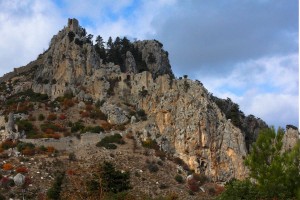 The closer you get, the more you can see the ruins rising out of the rock. Although the sun rarely emerged from behind the clouds, the sky did make for some interesting effects with HDR photography.
Going to the mountain for a second time had the advantage of knowing more what to expect and think ahead about composing photographs. Read the rest of this entry »
Posted in Uncategorized | 3 Comments »
November 11th, 2011
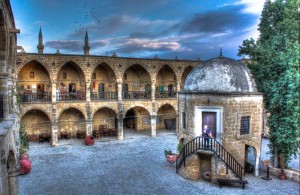 Buyuk Khan Two men from the National Endowment for the Humanities are here in Nicosia on a business trip for the NEH. I found out during the time they were interviewing me that they would like to visit the northern part of Nicosia. So Lynne and I took them on a walking tour through the checkpoint and along the winding, narrow streets. I think that my favorite site is the Buyuk Khan.
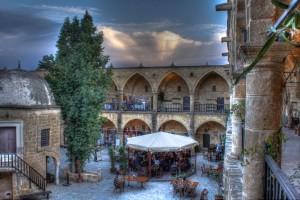 Buyuk Khan, looking south. Built about 1576, it is one of the earliest Ottoman structures in the city. The building was a sort of hotel, with 68 rooms and 10 shops. The downstairs rooms were used for stables, shops and storage rooms. Upstairs rooms had fireplaces and were used as bedrooms.
 Merged photo of the Buyuk Khan I like the fact that the Buyuk Khan is not like the Selimiye Mosque, which involved turning St. Sophia Cathedral into a mosque. The Khan represents Ottoman architecture, not piracy. It is a very cool building. I noticed that, as the sun was going down, the clouds were getting some nice color, so I did two HDR photos from the second floor. I also did a series of photos at the main entrance and stitched them together with Photoshop.
Posted in Uncategorized | Comments Off on Buyuk Khan
November 7th, 2011
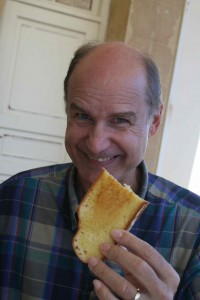 YUMMY Here is some evidence that I am on the mend. I have a good appetite. Today I walked to the Fulbright Center–not a challenging walk under normal circumstances, but a good sign that I am regaining some strength.
I have had several days of productive work, reflecting on how Joseph Barnabas came to be a potent symbol of Cypriot nationalism although the New Testament pictures him as an innovative leader who helped Jewish and Gentile Christians navigate the turbulent theological, ethnic and cultural issues that caused so many problems in the early church. He seems to have been effective at helping people reach compromise solutions. In my mind, our world needs such visionary Christian leaders who help people listen to each other and to work out mutually acceptable solutions to their conflicts.
Posted in Uncategorized | 2 Comments »
November 1st, 2011
This morning I went to a gastroenterologist. When Lynne called, he told us to come right on over. About time I saw a doctor, I know. I have lost nearly 20 pounds the past six days. I have no appetite, so I eat very little. Food makes me nauseous. Miserable would be an accurate word. I am so weak that when I stand up I get dizzy.
But here we go with connections again. The doctor had icons in his office. In the USA, one does not expect prolific religious symbols in a doctor’s office. Lynne asked the man if the icon of Barnabas on his shelf was one done by Fr. Gabriel. “Yes,” he replied. “I am one of his spiritual children.” He goes every month for sacred liturgy to the tomb of St. Barnabas near Salamis. We probably saw him there last month.
He asked questions about how long I have been ill, what I have been taking, etc. Then he examined me. Blood pressure and heart rate are fine. Lungs are clear…. “I will write prescriptions for medicines to help you to get over this.” After he wrote out a prescription and gave instructions, he smiled and said, “You should pray to St. Barnabas. Whenever I get sick, I ask Barnabas to help me get well.”
When we first got to his modest office facility, we saw no one in the waiting room. No receptionist. So Lynne knocked on a door after a few minutes. A little Greek doctor opened the door, smiled and invited us into his office/examination room. I was wondering what I had gotten myself into. He asked where we live in America. Lynne told him, and he replied, “Oh, then you are about two hours north of Baltimore.” Turns out that he worked a while at Johns Hopkins Hospital. I began to relax a bit.
After he gave me a prescription for multiple drugs, he also wrote out a receipt for payment (much less that a similar procedure would have cost at home). About that time, his wife came in with some coffee for him. She asked if I would like a cup of coffee. I declined. Overall, it was simply not the kind of medical experience I have grown to expect.
Now, I am taking two antibiotics, something to combat nausea, some powder-packets that I mix in water to help restore my messed up electrolytes, and something for the diarrhea. Most likely I got some bad food at a small café in Turkish occupied northern Cyprus last week. Getting sick is not an uncommon reality when traveling overseas. I am careful, but you never know for sure when some bacteria will lay you low. I am thankful that I did not have to be admitted to a hospital and have that cross-cultural experience. Been there. Done that. Don’t like it. But then, maybe my nurse would have known Fr. Gabriel.
Posted in Uncategorized | Comments Off on Bad food in Turkish Occupied Famagusta
October 31st, 2011
I have sick for five days with some sort of Cypriot crud. No travels, no research, no fun. Mostly just in bed. Nothing to report that the general public would particularly want to read. Hopefully in a few days I will be able to do some things.
Posted in Uncategorized | Comments Off on Sick for Days
October 27th, 2011
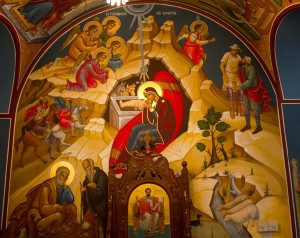 Note the chair in front of this Nativity painting on a chapel wall. On the back of the chair is a painting of Barnabas. I had an appointment this morning with a man at the Archbishopric to take photos of artwork depicting Barnabas. Although there often is a dearth of icons of Barnabas in churches around the island, he is everywhere in the Archbishopric.
Just inside the main door is a recent mosaic of Barnabas. In the archbishop’s office is a large painting of Barnabas on one of the walls (I did not yet get a photo of that one). In a chapel on the second floor, there are brand new paintings on the walls and ceiling. I noticed that the back of the chair in front of the painting depicting Jesus’ birth has an icon-like painting of Barnabas.
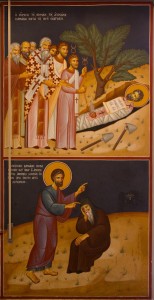 The bottom panel of this painting depicts Barnabas appearing to Anthemius in the late fifth century. The top panel depicts Anthemius finding Barnabas's body. In the main assembly room where the archbishop meets with people for business, a major part of one wall is devoted to depicting the late fifth-century events where, according to tradition, Barnabas appeared in a vision to Anthemius, Bishop of Constantia—showing his burial site. These paintings have for centuries been presented using four panels. The first is the vision. The second is Anthemius finding the body of Barnabas with a copy of the Gospel of Matthew on the apostle’s chest. The third is Anthemius presenting the Gospel of Matthew to the emperor Zeno. The fourth is the emperor Zeno giving a scepter to Anthemius, indicating the special, royal privileges given to the archbishop of Cyprus.
These four panels tell visually the story of how Cyprus maintained its ecclesiastical independence. Barnabas is the saint who helped to establish Cypriot autonomy—an important religious and political symbol for the Archbishopric in Nicosia.
The man who opened the doors for me and waited while I took the photos also walked with me out through the guard’s gate to the nearby Cathedral of St. John—an older structure covered inside with frescos. Of course, one of the frescos is a four-panel depiction of Anthemius finding the body of Barnabas, etcetera.
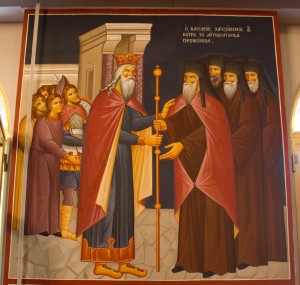 This panel shows the Emperor Zeno presenting a scepter to Anthemius. The fresco is weathered and faded. The church is very dim inside. And the fresco is right beside a window. Talk about a challenging set of conditions for taking photographs (without a flash, of course). So I used the HDR technique to produce an image that is semi-visible. I wish that I could have moved the chairs that block the view of the bottom two panels of the fresco. But I did not want to press my luck.
I smile sometimes when I think of how many of the significant Cypriot religious leaders I have met. Having a Fulbright and conducting research on Barnabas have opened lots of doors for me. Tonight, however, all these enriching experiences pale because of one irritating situation. For the first time since coming to Cyprus, I am sick. Miserable. I hope that it is a short-term illness and does not drag out for a week. Lynne’s mother and two sisters are flying to Cyprus on Friday, and I want to be in good shape for the visit.
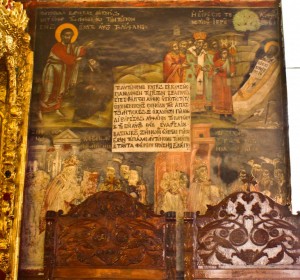 This old and weathered fresco in the national cathedral shows all four panels of the Anthemius cycle. Extremely challenging light conditions for taking this HDR photo.
Posted in Uncategorized | Comments Off on Barnabas at the Archbishopric
October 26th, 2011
This morning, while I was emerging from my I-just-woke-up stupor, I heard Lynne making disgusted and despairing noises in our little kitchen. When I went to see what the problem was, I saw a good-sized cockroach lying dead in the sink. Being the male, it was my job to remove the carcass.
A few minutes earlier, I had been making my morning cup of tea, using a hotpot that boils water with amazing speed. I had more boiling water than I needed, so I held the pot over the sink and poured out the water—not actually looking into the sink. So, here is the question. Was the roach already dead, or did I kill it with boiling water. I will never know.
But when I tell the story, I will indicate my prowess at killing my foe with skill and cunning, using only what I had available. My sons will embellish the story, and my grandchildren will add further details. We shall become known as the Roach Killer Clan (RKC) and have an honorable place in our village. Over the years, those who tell the story of my bravery will provide more and more details about the event, making it more worthy of its place in my culture’s lore.
Thus, through all generations, I shall be known as Roach Killer, and my descendants shall proudly bear the name of RKC and bask in the honor it brings to them.
Perhaps I have been studying oral traditions too much lately.
Posted in Uncategorized | 1 Comment »
|
|
 |
|
Monthly Archives:
Categorical Archives:
|





























